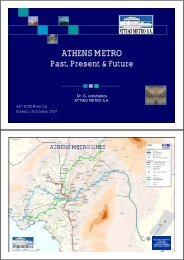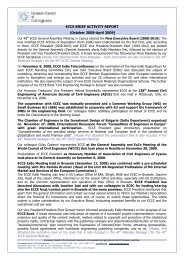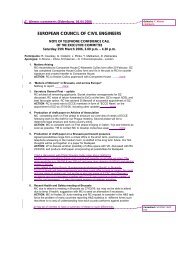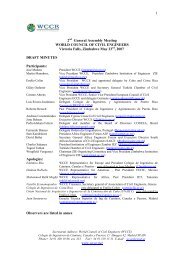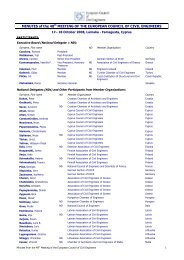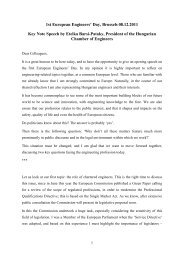A Closer Look at Prevailing Civil Engineering Practice - European ...
A Closer Look at Prevailing Civil Engineering Practice - European ...
A Closer Look at Prevailing Civil Engineering Practice - European ...
You also want an ePaper? Increase the reach of your titles
YUMPU automatically turns print PDFs into web optimized ePapers that Google loves.
A <strong>Closer</strong> <strong>Look</strong> <strong>at</strong> <strong>Prevailing</strong> <strong>Civil</strong> <strong>Engineering</strong> <strong>Practice</strong>, Wh<strong>at</strong>, Why and How<br />
Vincent T. H. CHU<br />
allowed to continue for several days before subjecting the new concrete to<br />
significant stress. The period of curing depends on the temper<strong>at</strong>ure<br />
because the r<strong>at</strong>e of all chemical reactions is dependent on temper<strong>at</strong>ure.<br />
Therefore, in summer the r<strong>at</strong>e of reaction (hydr<strong>at</strong>ion) is faster so th<strong>at</strong> a<br />
shorter curing time is required. On the contrary, in winter the r<strong>at</strong>e of<br />
reaction (hydr<strong>at</strong>ion) is slower so th<strong>at</strong> a longer curing time is required.<br />
9. How does rain affect the freshly placed concrete<br />
Rain may affect the w<strong>at</strong>er cement r<strong>at</strong>io <strong>at</strong> top portion of freshly placed<br />
concrete provided th<strong>at</strong> the concrete is not properly protected from rain. To<br />
substantially change the w<strong>at</strong>er-cement r<strong>at</strong>io of the concrete <strong>at</strong> the surface<br />
of the slab, external energy must be supplied to the system such as<br />
troweling passes with excess w<strong>at</strong>er on the concrete surface. The energy<br />
supplied by the finishing oper<strong>at</strong>ions pushes the excess w<strong>at</strong>er into the slab<br />
surface cre<strong>at</strong>ing a high w<strong>at</strong>er cement r<strong>at</strong>io in the near surface of the<br />
concrete so th<strong>at</strong> its strength and durability is reduced. Sometimes, the<br />
damage to the concrete surface is apparent since the texture of the surface<br />
is easily damaged after the initial curing period. When the surface strength<br />
is affected, the long-term durability of the concrete may be reduced.<br />
However, the concrete strength and durability below the surface would not<br />
be affected.<br />
10. Wh<strong>at</strong> is the purpose of uniform r<strong>at</strong>e of applic<strong>at</strong>ion of w<strong>at</strong>er (i.e. 2m<br />
depth in 24 hours) in w<strong>at</strong>ertightness test of w<strong>at</strong>er retaining<br />
structures<br />
In w<strong>at</strong>ertightness test of w<strong>at</strong>er retaining structures, it normally requires the<br />
filling of w<strong>at</strong>er <strong>at</strong> a uniform r<strong>at</strong>e or letting the w<strong>at</strong>er pool stand alone for<br />
some time before actual measurement is carried out. The reason for such<br />
provision in w<strong>at</strong>ertightness test is to allow sufficient time for w<strong>at</strong>er<br />
absorption to take place in concrete. After allowing sufficient time for w<strong>at</strong>er<br />
absorption to occur, the subsequent measurement of a fall in w<strong>at</strong>er level is<br />
deemed to be caused by w<strong>at</strong>er leakage instead of w<strong>at</strong>er absorption<br />
provided th<strong>at</strong> adjustment has been made to other external effects such as<br />
evapor<strong>at</strong>ion.<br />
11. Is curing compound suitable for all concrete<br />
For concrete structures with low w<strong>at</strong>er-cement r<strong>at</strong>io (i.e. less than 0.4), it<br />
may not be suitable to use curing compound for curing. When hydr<strong>at</strong>ion<br />
takes place, the rel<strong>at</strong>ive humidity of interior concrete drops which leads to<br />
17






